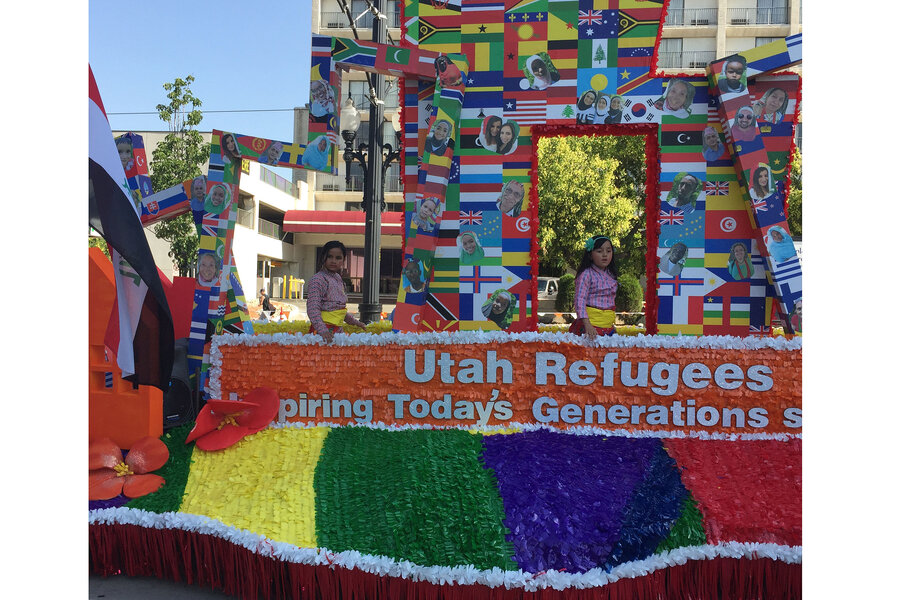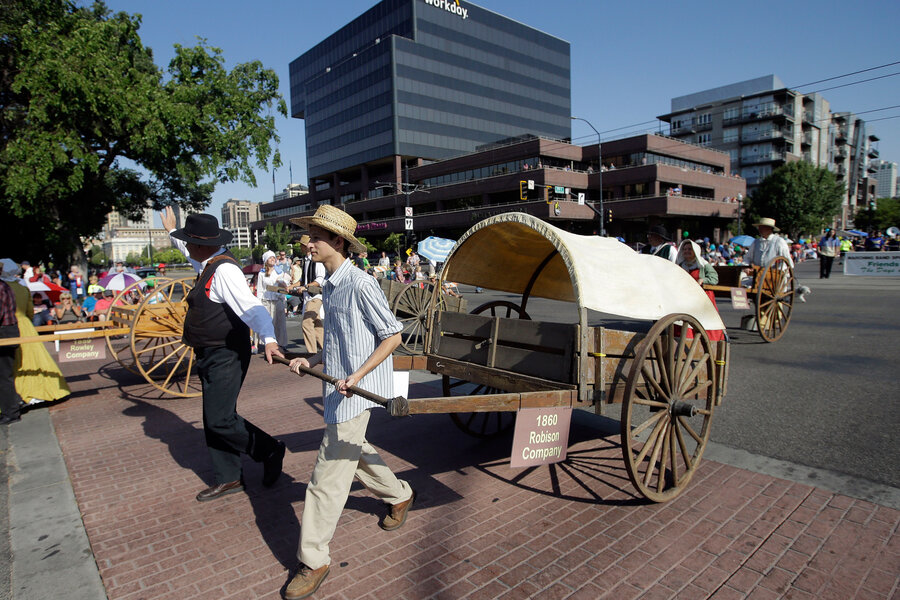Today's refugees find a place in Utah's Pioneer Day parade
Loading...
The Utah state holiday Pioneer Day often rivals the Fourth of July holiday with days of fireworks, rodeos, 19th-century reenactments, and – during this year's celebration – refugees from Salt Lake City's African and Middle Eastern communities.
On Monday, a float created by refugees symbolically bridged the gap between the refugees and the history of the unique Utah holiday, which commemorates the arrival of Mormon pioneers in the Salt Lake Valley on July 24, 1847.
The welcome of refugees into the state's prized parade comes in sharp contrast to anti-immigration sentiment about Middle Eastern refugees expressed by the Republican presidential candidate and some communities around the United States. To the parade organizers and participants, however, the experience of today's refugees is not all that different from that of many Americans' ancestors.
The float's base was in the shape of Utah, with a door symbolizing welcome, and refugees wearing native dress who marched and performed alongside it. It was designed to serve a dual purpose: showing the local community that the refugees had made Utah their new home and were prepared to contribute, and educating the newcomers about Utah's long history as a place of refuge, says Ze Min Xiao, Utah's refugee liaison and one of the float's organizers.
"We are connecting the communities together with things that are in common between them," Ms. Xiao tells The Christian Science Monitor.
Although Utah's land-locked locale and generally conservative politics might not seem to indicate a haven for refugees, Salt Lake City has one of the nation's largest refugee populations per capita, with roughly 1,100 to 1,200 entering annually, says Natalie El-Deiry, the deputy director at the International Rescue Committee (IRC) in Salt Lake.
Traditionally, Utah voters have voted for Republican presidential candidates. But other red-leaning states' initiatives to block refugees, particularly in the wake of the November terrorist attack in Paris, have failed to take similar hold in the Beehive State. Some attribute this to the Church of Jesus Christ of Latter-day Saints, to which 60 percent of residents belong, which has particularly emphasized helping immigrants and refugees, often drawing on the Mormon church's own history of persecution.
Anti-immigrant policies being used as a rallying cry in political discussions across the United States reflect tensions that stretch back to the nation's founding, as Patrick Jonsson explored in The Christian Science Monitor's January 17 cover story on Clarkston, Ga. – an "Ellis Island of the South" that has welcomed refugees:
Throughout history, America has always been the world’s premier melting pot – but has also had its share of backlashes to the influx of newcomers. In the 1780s, for instance, there were concerns in some areas that German was going to become the de facto official language in the US.
“You can go all the way back to the Colonial era and there are these persistent strands of an us-versus-them mentality, though the definition of who is ‘us’ and who is ‘them’ has changed over time,” says University of Washington professor Jacob Vigdor, a fellow at the Centre for Research and Analysis of Migration at University College London.
Part of the periodic resistance has been driven by the immigrants themselves: the proclivity of many of them to want to close the doors behind them once they have arrived. But the backlash to today’s refugees is rooted in two other powerful forces: first, a slowdown in middle-class mobility in a changing and often struggling US economy, and, now, a tangible national security threat from the Middle East.
Utah's decision to welcome newcomers in the Pioneer Day parade came amid heated discussion among political candidates about the perceived dangers of welcoming new refugees into the United States.
Julie McAdams, the associate general counsel for the Salt Lake-based University of Utah and wife of the Salt Lake County mayor, saw the parade as a visible bridge between her own heritage as a lifelong Utahn and Latter-day Saint, and the identities of modern-day refugees.
In April, the Mormon church launched a new program called "I was a stranger," comparing the world's modern-day refugees to the history of Mormon settlers who were driven out of several states in the 1800s.
"Prayerfully determine what you can do – according to your own time and circumstance – to serve the refugees living in your neighborhoods and communities," said Linda Burton, president of the church's women's organization, in a speech announcing the program. "As we consider the 'pressing calls' of those who need our help, let’s ask ourselves, 'What if their story were my story?'"
Interest in volunteer work spiked after the church announced its program. The number of volunteers in Utah locations quadrupled after the program began in April, says Aden Batar, refugee resettlement director for Catholic Community Services. Mr. Batar hired an additional volunteer coordinator to keep up with an increased interest that shows no signs of slowing.
Although Utahns across the religious spectrum have volunteered their time and resources to help refugees, Xiao says the willingness to welcome stems in part those who travel around the world for two-year Mormon missions. They learn local languages and cultures as they try to spread their faith, then return with a greater appreciation for other backgrounds.
In the lead-up to the 2016 parade, many refugees were initially nervous that politics could dim the celebratory day. Afterward, however, several were moved to tears by the positive reception they received, says Ms. McAdams, who walked with the float.
"That is the whole reason I did this – so there could be those individual experiences where they felt welcome and part of the community, that people were happy they were there," McAdams says.
Several parade-watchers created their own handmade signs saying, "Welcome" as the float passed.
"With some of the things that you’re hearing around the country, this is the opposite message that you’re seeing in Utah," says Xiao, who recently moved to Utah from San Francisco. "I think it really goes back to the history of Utah, because when the pioneers first came they sought refuge.... They are also making sure that [refugees] have the same opportunities that their ancestors did."
[Editor's note: An original version of this story gave the incorrect last name for Natalie El-Deiry.]







